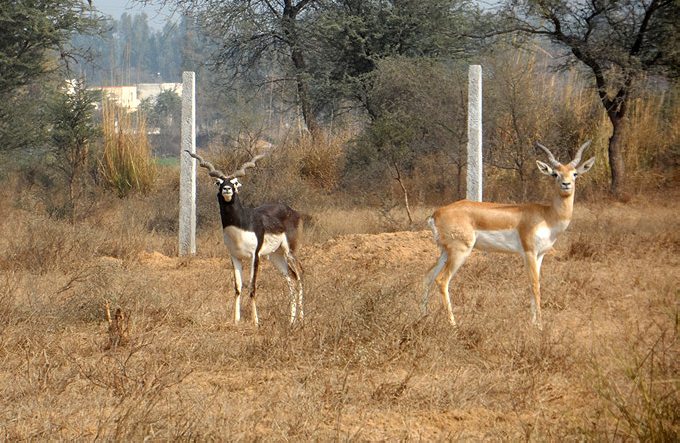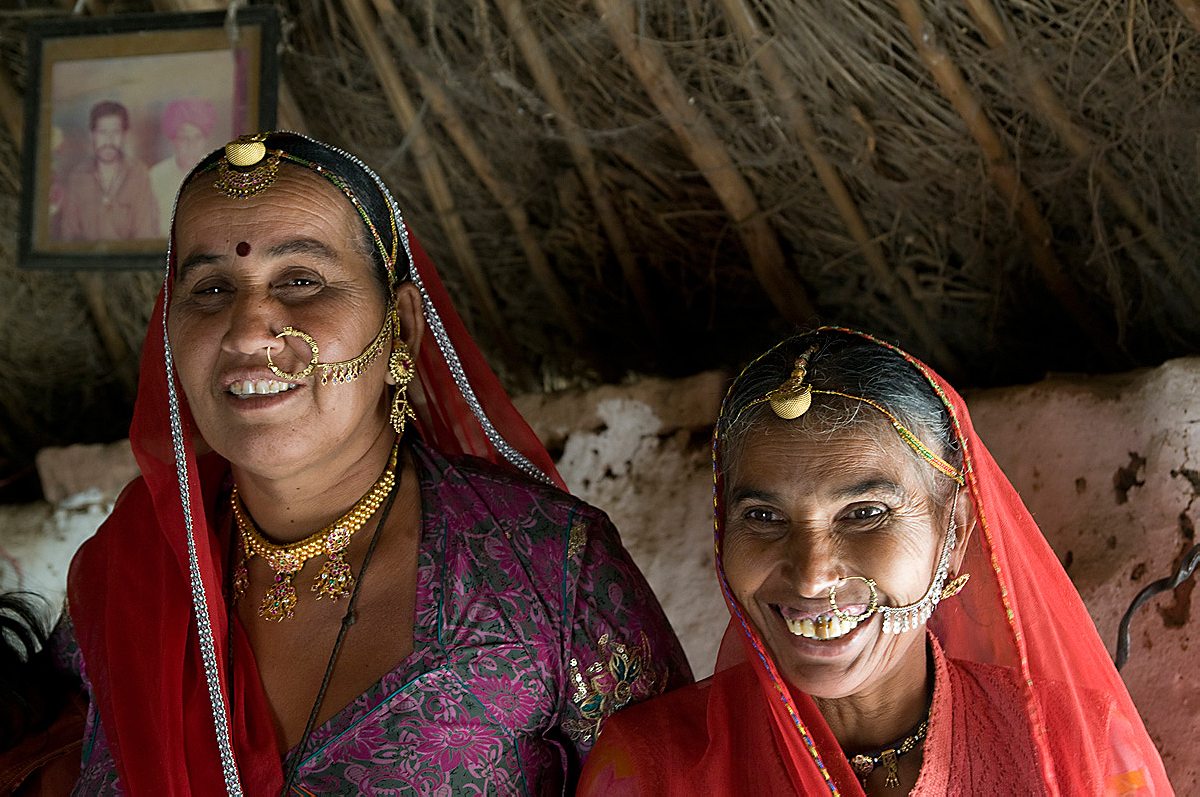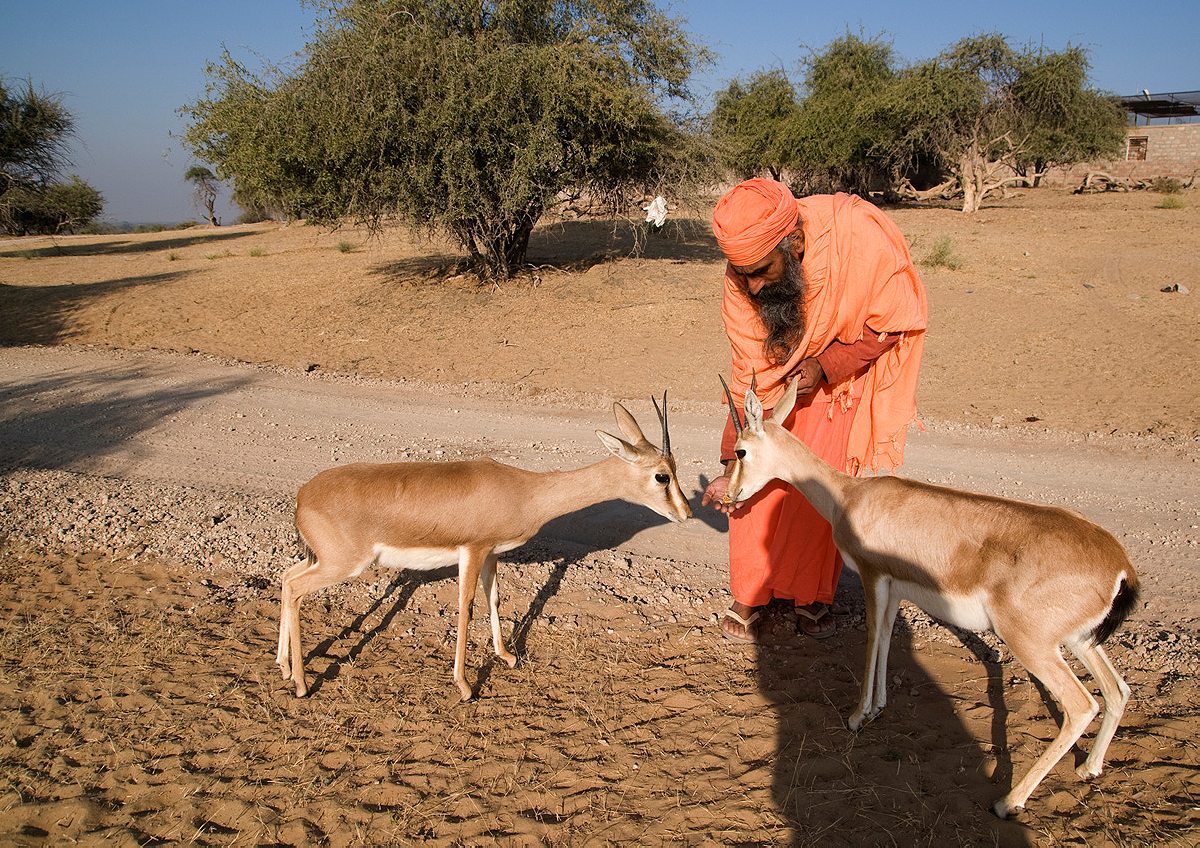For more than 500 years, the Bishnoi people have been following their founder’s admonition to protect the environment at all costs
It was late in the afternoon and the desert sun had just begun to mellow. Sunil swerved the jeep and we descended onto a bumpy dirt track through the fields of wheat and millet that grew sparsely here in the Thar Desert. We stopped the car in a clearing and switched off the engine.
And suddenly they came. A group of four gazelles, followed by a large herd of blackbuck antelope, the afternoon sun glancing off their elegant backs. From previous experience, I knew that if I took out my long telephoto lens, the herd would scatter. Sensing my hesitation, Sunil smiled. “Don’t worry. They will not think that you are aiming a gun at them. They roam fearlessly here, because this is the land of the Bishnois.”
The camp at Guda Bishnoi village lies only 22 km from the bustling city of Jodhpur, but the silence there is almost sepulchral. In the evening we sat sipping the strong tea made from camel’s milk, and I listened to Khemkaran Bishnoi, my host in this village camp. He was telling me the story of their community, the Bishnois. In the later part of the 15th century, this part of Western Rajasthan was hit by severe drought and famine each year and it was the custom to migrate to Malwa, a central Indian province, at the start of the summer. Legend has it that Jambeshwar, son of a local Rajput thakur (chieftain), stopped the migration by devising a clever rationing program for his people. It was then, in 1485, he introduced the twenty-nine principles of the Bishnoi sect (“Bish” means twenty and “Noi” means nine). Thus the Bishnoi tradition was born.
Those same 29 principles are still followed (mostly) by the Bishnoi today. Some of the principles are not unusual: take daily baths, pray in the morning and the evening. Some are practical: don’t steal, smoke, drink or use drugs (with, strangely enough, a seemingly wide loophole that allows opium ceremonies). Some would seem chauvinist to the modern ear: segregate menstruating women and those who have just delivered children. Others, just strange: don’t use the violet blue color from the indigo plant. But the six principles that cover environmental protection and compassion for all living creatures are extraordinary. It goes far beyond prohibiting meat (though it includes that). Rather, the Bishnoi are commanded to provide shelter for abandoned animals and to be merciful to all beings. It is likewise forbidden to castrate bulls or cut down trees. It’s an ancient religious creed, but it is, at its core, environmentalism.
This ancient creed has translated into modern activism: this month, the Bishnoi launched a hunger strike in protest of a proposed nuclear power plant site in Fatehabad in the north Indian state of Haryana. The site is home to endangered wildlife like blackbucks and blue bulls, some of whom have already been dying due to the new metal fencing around the area. The strike will continue, says activist Vinod Karwasra Bishnoi, even though reversing the project plan would be, as he put it, a ‘herculean task’.

The next morning we were on our way to Khejarli village, a 12km drive from Guda Bishnoi. This is the holiest sanctuary of the Bishnois, named after the Khejri tree, a hardy flowering tree that grows in the desert. These trees, as all others, were beloved by the Bishnoi, and in 1730, when a king sent his men to cut the Khejri trees down to fuel the cement lime kilns to build his palace, the Bishnoi resisted. They clung to the trees even as the king’s men began slaughtering them; according to folklore, the first martyr, Amrita Devi, said “a chopped head is a cheap bargain for a felled tree” before she died. In all, 363 men, women and children were killed, and their sacrifice is commemorated here: A large mausoleum stands beside a Khejri tree, named the Amrita tree, in honor of its protector. A temple of Guru Jambeshwar stands guard over it.
Sunil stood admiring the tree with me. “It is still a custom among us to buy khejri saplings from this village and plant them in our homes,” he said. “We share our own water with the saplings for two years and then it can grow on its own. The wood makes good furniture but a Bishnoi carpenter would never cut a green tree. It would wait for the trees to die naturally.”

An early morning excursion to the temple of the Bishnois, 25 km from Jodhpur, was a journey through the desert. A small religious ceremony was to be held in the morning. The chill was palpable as dry, icy winds cut through the air and rattled my bones as soon as I got out of the car. It was 7.30 in the morning and already the havan (holy fire) was lit inside the temple. The high priest was chanting prayers. Men—in their traditional white clothing—and women—draped in colorful saris—were pouring pure ghee (clarified butter) and coconut milk into the fire as they slowly circled it clockwise. “It purifies the air and clears our passage to our Guru”, Vishudha Nand, the head priest explained. After the ceremony he took me around back, where some twenty gazelles were ambling about, picking up the grains of wheat and millet left for them by the villagers. Nand explained that the Bishnoi have a kind of environmental tithing system, sharing ten percent of all their grains with wildlife.
A fawn walked slowly towards us. The priest called out to her by name—Aarti. The little antelope fearlessly trotted in. Nand said “Aarti’s mother died when she was born. A Bishnoi woman adopted her, breastfeeding her with her own children until the motherless fawn could be on her own.”

I offered a couple of biscuits to Aarti. She accepted them gracefully and went on rubbing her nose on the priest’s orange robes.
Our next stop was Salawas, a predominantly Bishnoi village. The traditional mud houses are being replaced with modern urban homes, made of Jodhpuri stone. The young women wore ubiquitous salwar kameez, the standard dress throughout northern and western India, and only the older women seemed to keep tradition, with elaborate nose rings extending up to their ears and heavy lockets and bangles—all, I was told, made of pure gold.
I was taken to Jodha Ram’s house for the opium ceremony. An ancient custom among the Bishnois, it is still popular among some of the village elders, who believe that the drug has healing properties, despite the somewhat explicit prohibition (laid out in rule #24 of the 29 Bishnoi strictures). In olden times, I am told, fights between clans were often resolved through an opium ceremony.

The ceremony was elaborate: village elders, dressed all in white with meticulous turbans, religiously took their turns. As a guest, I was offered to partake, but opium that strong is clearly more appealing to elderly villagers than me. I declined.
On the way back, Sunil and I briefly stopped at Guda Lake, which like much of the water was a painstakingly created Bishnoi rain reservoir in a land known for water scarcity. Gazelles and blackbucks drank from the water—it’s also an important stop for migratory birds in winter. A few kilometers later, near Khejarli village, Sunil stopped the car and pointed to a large stone. “This is where Salman Khan had shot the two blackbucks in 1998.” I remembered the case, which had received widespread media attention. Salman Khan, the Bollywood superstar had killed two blackbucks. What fewer might remember about the incident is that it was Bishnoi villagers who chased him down afterwards and handed him to the police. He was later sentenced to a 5-year prison term, though he never served time. There was tremendous pressure on the Bishnoi community from many quarters to withdraw the charges but to no avail. Sunil grew angry at the memory: “How could they think that for a community whose ancestors have given so great a sacrifice to save trees would let go the killer of a deer, whom we consider part of our family?”